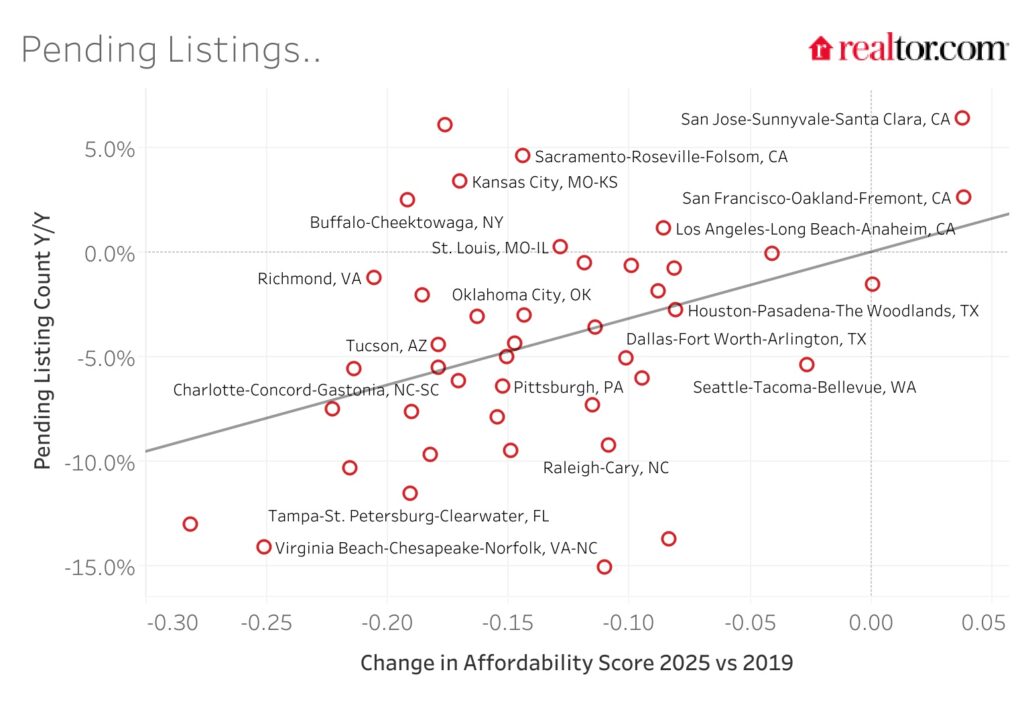As more properties came onto the market and overall inventory increased for the 17th consecutive month, the U.S. housing market showed signs of a sustained recovery this spring, according to Realtor.com‘s March Housing Trends Report. Nonetheless, increasing price reductions and declining pending house sales indicate that buyers are being cautious, most likely as a result of the uncertain economic climate and customers’ growing anxieties about their individual financial circumstances.
“The spring housing season is beginning with more sellers and a growing number of homes for sale,” said Danielle Hale, Chief Economist at Realtor.com. “But the high cost of buying coupled with growing economic concerns suggest a sluggish response from buyers in early spring. We’re seeing a market that’s rebalancing, offering more choices for shoppers. Data also suggest that pricing competitively is key for sellers in today’s environment. This is likely to be even more true after the mid-April Best Time to Sell, when the number of sellers grows even more swiftly. Recent improvements in mortgage rates bode well for the later spring and early-summer housing season, as long as economic concerns settle and don’t knock buyers off course.”
Key Highlights — U.S. Summary
- Major metro regions saw a 5.2% decline in pending house sales, or homes under contract, as buyers were burdened by high mortgage rates and financial uncertainties.
- For the seventeenth consecutive month, the number of available homes increased by 28.5% year-over-year.
- Compared to the previous year, there were 17.3% more unsold properties overall, including those under contract.
- March saw the greatest number of new home listings in three years, up 10.2% over the previous year.
- The price per square foot increased 1.3%, indicating modest improvement in home values, but the national median list price for homes remained at $424,900, unchanged from the previous year.
- Three more days were spent on the market than a year ago, with a median of 53 days spent on the market.
- Price reductions affected 17.5% of listings, the largest percentage for any March since at least 2016.

March 2025 Housing Metrics – National
| Metric | Change over Mar. 2024 | Change over Mar. 2019 |
| Median listing price | +0.0% (to $424,900) | +38.9 % |
| Active listings | +28.5 % | -20.0 % |
| New listings | +10.2 % | -8.8 % |
| Median days on market | +3 days (to 53 days) | -12 days |
| Share of active listings with price reductions | +2.5 percentage points(to 17.5%) | +2.5 percentage points |
| Median List Price Per Sq.Ft. | +1.3 % | +54.7 % |
Realtor.com’s data on pending home listings indicates that buyer enthusiasm slowed in March as the number of pending listings and properties under contract in the country’s top metro areas decreased 5.2% year-over-year. 36 of the 44 metro areas examined for this statistic reported lower pending sales than in March of previous year.
In the top three markets experiencing a reduction in pending home sales, Virginia Beach, VA (-14.2%), which has a high proportion of federal government employees, and Jacksonville and Miami (-15.1% and -13.7%), where the market has been declining recently, saw some of the biggest drop-offs. Remarkably, with a 7.9% annual reduction, Washington, D.C., which likewise has a large proportion of federal government employees, came in at number ten.
However, some markets defied the trend, such as Sacramento, CA (+4.6%), Grand Rapids, MI (+6.1%), and San Jose, CA (+6.4%), all of which saw YoY increases in pending listings. This suggests that local factors, like tighter supply or better buyer sentiment, may be keeping those markets more competitive.
With the national median list price at $422,450, down just 0.1% from a year earlier, list prices stayed largely unchanged. But as 17.4% of active listings had price decreases in March—the highest percentage for any March since 2016—more sellers are adjusting their listings.
Among large metros, the biggest annual price increases were:
- Baltimore (+11.9%)
- Providence (+10.0%)
- Hartford (9.9%)
Compared to March 2019, every large metro has seen price growth. The biggest gains since pre-pandemic times include:
- Memphis (+56.8%)
- Los Angeles (+53.0%)
- Boston (+52.1%)
The smallest long-term price gains were in:
- San Francisco (+3.6%)
- Detroit (+5.2%)
- Chicago (+9.9%)
Price reductions are typically more common in markets when buyer demand is decreasing, such as when there are more homes for sale or fewer homes under contract than there were a year earlier.

Additional Price Cuts & Buyer Trends
- Price reductions were most prevalent in Phoenix (32.6%), Tampa, FL (28.9%), and Jacksonville, FL (27.7%), where sellers are under pressure to maintain their competitiveness due to excessive inventory levels and/or muted demand.
- Conversely, the markets with the lowest percentage of price reductions were Buffalo, NY (5.4%), Hartford, CT (5.5%), and New York (7.0%), indicating tighter inventory and stronger pricing power.
- In many sectors, this gives buyers more negotiating leverage, but in other areas, pricing and competition are still rather high.
- While sellers in tighter markets can still profit from strong demand if they price their products appropriately, those in high-reduction markets would need to adjust their expectations.
U.S. Supply Gap Persists Despite Spring Jump in Inventory
March had the largest March showing in three years, with newly listed properties rising 10.2% and the overall number of homes currently for sale jumping 28.5% from the same month last year. Locally, every one of the 50 major metro areas reported an increase in inventory each year; the biggest increases were in San Jose, CA (+67.9%), Las Vegas (+67.8%), and Denver (+67.3%).
In addition to seeing notable year-over-year increases, San Jose, CA, Denver, and Las Vegas are among the 18 metro areas whose inventory levels have surpassed those of the pre-pandemic period, along with Austin (+44.2%), Dallas (+44.9%), and San Antonio (+49.6%).
Overall, per Realtor.com’s latest report, March saw further moderation across the U.S. housing market, giving homebuyers more options as inventory increased for the 17th consecutive month—with new listings reaching their highest level in three years compared to the same time last year.
To read the full report, click here.






